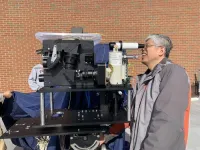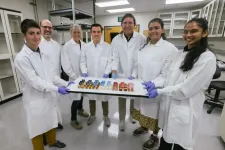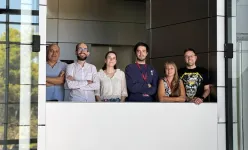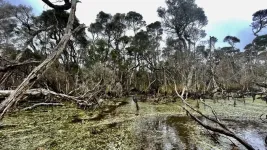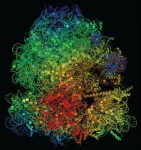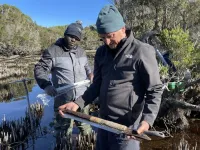(Press-News.org) A new UC Davis Health study has uncovered how Salmonella bacteria, a major cause of food poisoning, can invade the gut even when protective bacteria are present. The research, published in the Proceedings of the National Academy of Sciences, explains how the pathogen tricks the gut environment to escape the body's natural defenses.
The digestive system is home to trillions of bacteria, many of which produce short-chain fatty acids (SCFAs) that help fight harmful pathogens. But Salmonella manages to grow and spread in the gut, even though these protective compounds are present. The study asks: How does Salmonella get around this defense?
“We knew that Salmonella invades the small intestine, although it is not its primary site of replication. The colon is,” said the lead author of the study Andreas Bäumler. Bäumler is a UC Davis distinguished professor and vice chair of research in the Department of Medical Microbiology and Immunology.
Bäumler and his team discovered that the answer lies in how the pathogen changes the gut’s nutrient balance. When Salmonella enters the small intestine, it causes inflammation in the gut lining and disrupts the normal absorption of amino acids from food. This creates an imbalance in nutrients in the gut.
The imbalance gives Salmonella the resources it needs to survive and multiply in the large intestine (colon), where beneficial bacteria usually curb its growth. The study showed that salmonella causes inflammation in the small intestine in order to derive nutrients that fuel its replication in the colon.
Salmonella alters gut nutrient environment to survive
Using a mouse model, the team looked closely at how Salmonella changed the chemical makeup of the gut. They traced amino acid absorption in the small and large intestines.
They found that in mice that were infected with Salmonella, there was less absorption of amino acids into the blood. In fact, two amino acids, lysine and ornithine, became more abundant in the gut after infection. These amino acids helped Salmonella survive by preventing the growth-inhibiting effects of SCFAs. They did this by restoring Salmonella’s acidity (pH) balance, allowing the pathogen to bypass the microbiota’s defenses.
“Our findings show that Salmonella has a clever way of changing the gut’s nutrient environment to its advantage. By making it harder for the body to absorb amino acids in the ileum, Salmonella creates a more favorable environment for itself in the large intestine,” Bäumler said.
In the study, the team showed that Salmonella uses its own virulence factors (disease causing molecules) to activate enzymes that break down key amino acids like lysine. This helps the pathogen avoid the SCFAs’ protective effects and grow more easily in the gut.
New insights could lead to better gut infection treatments
The new insights potentially explain how the gut environment changes during inflammatory bowel disorders , such as Crohn's disease and ulcerative colitis, and could lead to better treatments for gut infections. By understanding how Salmonella changes the gut environment, researchers hope to develop new ways to protect the gut microbiota and prevent these infections.
“This research uses a more holistic approach to studying gut health. It not only gives us a better understanding of how Salmonella works, but also highlights the importance of maintaining a healthy gut microbiota,” said Lauren Radlinski, the study’s first author and postdoctoral fellow in the Bäumler Lab. “Our findings could lead to new treatments that help support the microbiota during infection.”
The study’s results could inspire future treatments, including probiotics or dietary plans designed to strengthen the body’s natural defenses against harmful pathogens.
“By learning how a pathogen manipulates the host’s system, we can uncover ways to boost the host’s natural defenses,” Radlinski said.
Coauthors of the study are Andrew Rogers, Lalita Bechtold, Hugo Masson, Henry Nguyen, Anaïs B. Larabi, Connor Tiffany, Thaynara Parente de Carvalho and Renée Tsolis of UC Davis.
END
New study shows how salmonella tricks gut defenses to cause infection
2024-11-15
ELSE PRESS RELEASES FROM THIS DATE:
Study challenges assumptions about how tuberculosis bacteria grow
2024-11-15
The rod-shaped tuberculosis (TB) bacterium, which the World Health Organization has once again ranked as the top infectious disease killer globally, is the first single-celled organism ever observed to maintain a consistent growth rate throughout its life cycle. These findings, reported by Tufts University School of Medicine researchers on November 15 in the journal Nature Microbiology, overturn core beliefs of bacterial cell biology and hint at why the deadly pathogen so readily outmaneuvers our immune system and antibiotics.
"The ...
NASA Goddard Lidar team receives Center Innovation Award for Advancements
2024-11-15
NASA researchers Guan Yang, Jeff Chen, and their team received the 2024 Innovator of The Year Award at the agency’s Goddard Space Flight Center in Greenbelt, Maryland, for their exemplary work on a lidar system enhanced with artificial intelligence and other technologies.
Like a laser-based version of sonar, lidar and its use in space exploration is not new. But the lidar system Yang and Chen’s team have developed — formally the Concurrent Artificially-intelligent Spectrometry and Adaptive Lidar System (CASALS) — can produce higher resolution data within a smaller space, significantly increasing efficiency compared to current models.
The ...
Can AI improve plant-based meats?
2024-11-15
Cutting back on animal protein in our diets can save on resources and greenhouse gas emissions. But convincing meat-loving consumers to switch up their menu is a challenge. Looking at this problem from a mechanical engineering angle, Stanford engineers are pioneering a new approach to food texture testing that could pave the way for faux filets that fool even committed carnivores.
In a new paper in Science of Food, the team demonstrated that a combination of mechanical testing and machine learning can describe food texture with striking similarity to human taste testers. Such a method could speed up the development of new and better plant-based meats. The team also found that ...
How microbes create the most toxic form of mercury
2024-11-15
Mercury is extraordinarily toxic, but it becomes especially dangerous when transformed into methylmercury – a form so harmful that just a few billionths of a gram can cause severe and lasting neurological damage to a developing fetus. Unfortunately, methylmercury often makes its way into our bodies through seafood – but once it’s in our food and the environment, there’s no easy way to get rid of it.
Now, leveraging high-energy X-rays at the Stanford Synchrotron Radiation Lightsource (SSRL) at the U.S. Department of Energy’s SLAC National Accelerator Laboratory, ...
‘Walk this Way’: FSU researchers’ model explains how ants create trails to multiple food sources
2024-11-15
It’s a common sight — ants marching in an orderly line over and around obstacles from their nest to a food source, guided by scent trails left by scouts marking the find. But what happens when those scouts find a comestible motherlode?
A team of Florida State University researchers led by Assistant Professor of Mathematics Bhargav Karamched has discovered that in a foraging ant’s search for food, it will leave pheromone trails connecting its colony to multiple food sources when they’re available, ...
A new CNIC study describes a mechanism whereby cells respond to mechanical signals from their surroundings
2024-11-15
To the casual eye, a memory foam mattress would appear to have no relationship to the behavior of cells and tissues. But an innovative study carried out at the Centro de Investigaciones Cardiovasculares (CNIC) in Madrid shows that viscoelasticity—the capacity of a material to be compressed and then recover its original form, like memory foam—is a little-explored property of biological tissues that is essential for correct cell function.
Study leader Dr. Jorge Alegre-Cebollada, who heads the Molecular Mechanics of the Cardiovascular System laboratory at the CNIC, explained that proper cell function requires ...
Study uncovers earliest evidence of humans using fire to shape the landscape of Tasmania
2024-11-15
Some of the first human beings to arrive in Tasmania, over 41,000 years ago, used fire to shape and manage the landscape, about 2,000 years earlier than previously thought.
A team of researchers from the UK and Australia analysed charcoal and pollen contained in ancient mud to determine how Aboriginal Tasmanians shaped their surroundings. This is the earliest record of humans using fire to shape the Tasmanian environment.
Early human migrations from Africa to the southern part of the globe were well underway during the early part of the last ice age – humans reached northern ...
Researchers uncover Achilles heel of antibiotic-resistant bacteria
2024-11-15
Recent estimates indicate that deadly antibiotic-resistant infections will rapidly escalate over the next quarter century. More than 1 million people died from drug-resistant infections each year from 1990 to 2021, a recent study reported, with new projections surging to nearly 2 million deaths each year by 2050.
In an effort to counteract this public health crisis, scientists are looking for new solutions inside the intricate mechanics of bacterial infection. A study led by researchers at the University of California San Diego has discovered a vulnerability within strains of bacteria that are antibiotic resistant.
Working with labs at Arizona State University and the Universitat ...
Scientists uncover earliest evidence of fire use to manage Tasmanian landscape
2024-11-15
Some of the first humans to arrive in Tasmania, over 41,000 years ago, used fire to shape and manage the landscape, a new study from The Australian National University (ANU) and the University of Cambridge has found.
It is thought to be the earliest and most detailed record of humans using fire in the Tasmanian environment.
According to the researchers, early inhabitants of Tasmania were managing forests and grasslands by burning them to create open spaces, possibly for food procurement and cultural activities.
The team analysed traces of charcoal and pollen contained in ancient mud that showed how Indigenous Tasmanians (Palawa) ...
Interpreting population mean treatment effects in the Kansas City Cardiomyopathy Questionnaire
2024-11-15
About The Study: Inferences about clinical impacts based on population-level mean treatment effects may be misleading, since even small between-group differences may reflect clinically important treatment benefits for individual patients. Results of this study suggest that clinical trials should explicitly describe the distributions of Kansas City Cardiomyopathy Questionnaire change at the patient level within treatment groups to support the clinical interpretation of their results.
Corresponding ...
